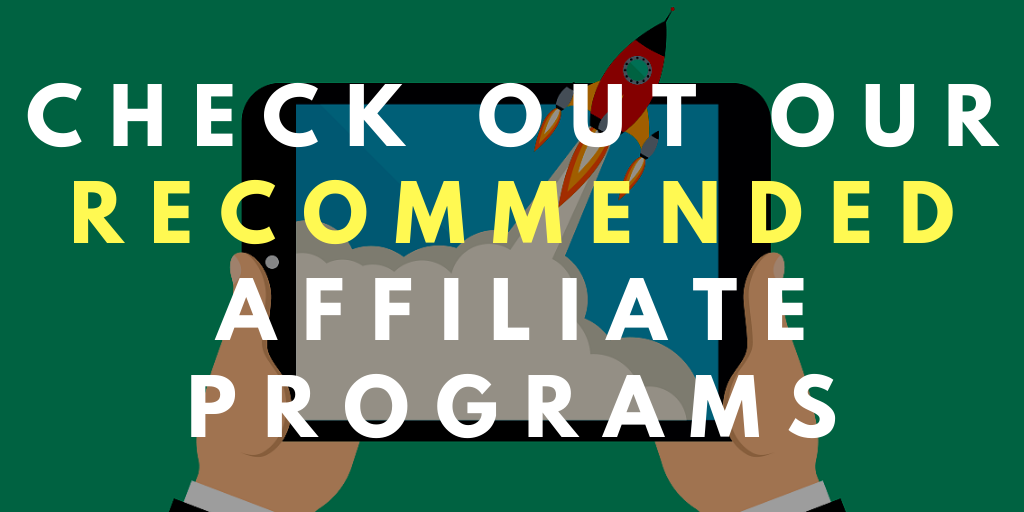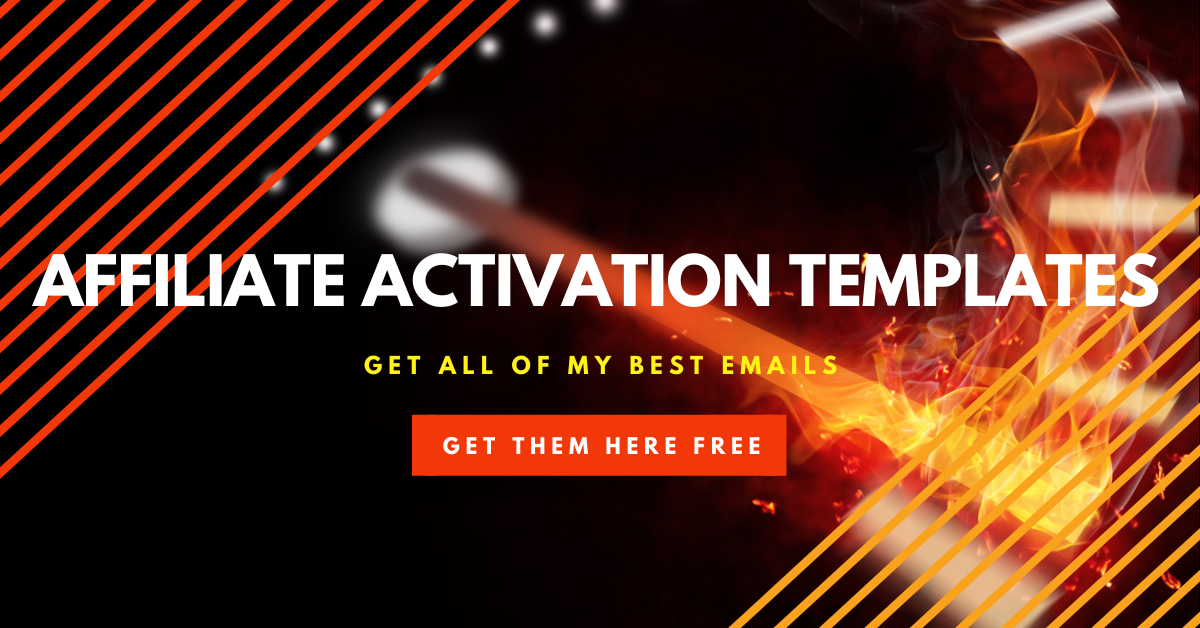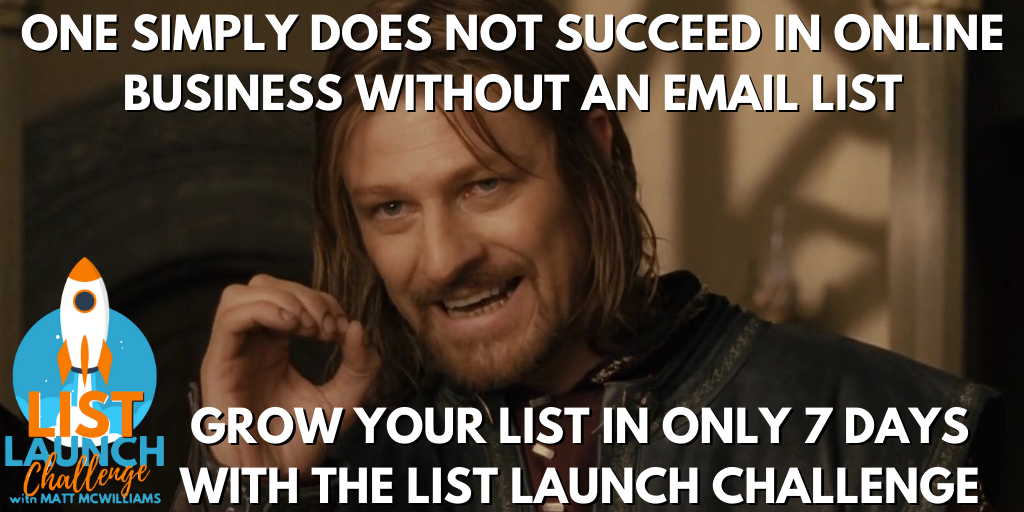Social media is all the rage…and has been for a while now. Whether it’s Tik Tok, Instagram, Facebook, or whatever new platform pops up next month, everyone is talking about how to optimize social media and make money from it. But, the statistics don’t lie…email still outperforms social media nearly 50 to 1 in terms of sales. So, what are the secrets to better email marketing? Today’s guest tells all.
Click Here for The Written Transcript of This Episode
Looking for some good affiliate programs to promote? Check out our recommended affiliate programs here!
LINKS MENTIONED IN THIS EPISODE
Text me at 260-217-4619
Don’t Miss An Episode – Subscribe Below
Previous Episodes of The Affiliate Guy
How to double your affiliate commissions in 30 days or less
10 Lessons I Learned Launching a Bestselling Book
Listener Q&A: Finding Affiliates, What’s Working in Affiliate Recruiting, Email Templates, and More
How to Create Recurring Affiliate Revenue Promoting Membership Sites
Email Marketing vs. Social Media Advertising: Which is More Effective? Insights from Igor Kheifets
Social media is all the rage today, and it has been for a while. Whether it’s TikTok, Instagram, Facebook, whatever new platform pops up next month, next week. By the time this episode is over, everyone is talking about how to optimize social media and making money from it.
But the statistics don’t lie. Email still outperforms social media nearly 50 to one in terms of sales. So what are the secrets to better email marketing?
Well, today’s guest tells all.
So this is something I don’t talk enough about email marketing. I of course share little tips here and there as we’re talking about affiliate marketing, but I haven’t really just done a deep dive interview about email, actually, ever. This is roughly the 540th episode of this podcast I’ve ever recorded.
And I’ve never done a deep dive interview. I’ve done a few special episodes, maybe like five out of 540 to date where I talked about email, but I’ve never done an interview all about email marketing until today. I invited my friend Igor Kheifets in.
He shared some interesting stats that line up closely to what we found about social media versus email. And this is something that we’ve studied with our clients, with our clients affiliate promos. How do leads convert into sales?
And one of the things that we found is if you go back to 2015, the first time I shared this stat, I said that it was one to 22 and I felt like social media was becoming in fact, you can find the blog post if you look up social media on mattmcwilliams.com. We haven’t edited it.
It’s a post from 2015 where I said that a social media follower is worth 122nd of an email subscriber. And my belief was that by the end of the decade, it would be only ten times more for an email subscriber. I felt like things were shifting in the direction of social media and boy was I wrong?
I was flat out wrong. I shared recently how we found that, okay, social media in 2015 went from 122nd 2018, it was 128th. Now this is conversions from click to lead to sale.
In other words, if I have 1000 email subscribers, back in 2015, it took me 22,000 social media followers to equal the same firepower in terms of how much money I’m going to make. And then fast forward three years later, it took me 28,000. 2020, it would have taken 32,000. And our studies have found that in 2022 we were approaching 150th.
We were approaching the territory where it would take 50,000 social media followers to equal 1000 email subscribers. And the stats have proven true over and over again. So if you ask me for some reason, if somebody only has, let’s say they have 5000 email subscribers or 100,000 social media subscribers and a list of only 2000, I probably would rather take the person with the 5000 email subscribers and no social media followers.
That’s what the statistics have shown. So Igor shares some other statistics that he’s found that are pretty much line up, and I think that’s really good verification. He and I have found a few things that we verified over the years.
I was chatting with his affiliate manager the other day, and she was like, well, Igor does his webinars at Thursdays at 02:00 p. m. Eastern.
I go, oh my gosh, that’s when we do ours. She’s like, yeah. He tested hundreds of different possibilities.
That’s what he found. I went, oh my gosh, that’s what we found too. Eastern on Thursdays was the optimal time to do webinar for our audiences.
Could be different for yours. Just to be clear, if you’ve got a different audience, very well could be at a very different time. We found with some other clients, sunday nights worked best.
Interesting, right? So it was just interesting how everything is lined up with Igor. And so I’m excited because I invited him to share why email outperforms social media and his best email marketing strategies.
This ended up being an incredible conversation that I’m excited to dive into. So let’s do it.
Need help activating your affiliates? Use my proven email templates for getting inactive affiliates in the game and making sales! Get them here!
Matt: Hey, what’s up, Igor? Welcome, buddy.
Igor: My pleasure, my pleasure. Man.
Matt: I’m really excited about this. Me too, man. I’m so excited because you’re all about email marketing and we’ve had some amazing guests on.
People have talked about social media, things like that, but not a whole lot on email. It’s actually been a couple of years since we had anybody specifically come on and talk about email marketing. So I’m excited for that.
I’m just curious, like, it’s a starting point. Why do you have such a love affair with email? What’s your deal, man?
Igor: What’s the deal with email? Well, it’s really hard to hate the thing that makes you the most money, I guess. When I sit down and I track every dollar that’s coming in, I can usually track almost every dollar, maybe $9 out of ten back to my email list somehow.
Email seems just to be the sort of media that just results in transactions, be it deals or be it being able to sell, whatever that is. I mean, even this podcast happened as a result of an email exchange. It didn’t happen on social media.
So, I mean, for me, there’s something magical about email in a way where it’s the media we use to do anything business, anything that requires actual decisions, like any kind of discussion that’s a serious discussion where there’s decisions to be made. Usually it’s an email discussion. Like, if I’m buying a property, I’m talking to my broker or a lawyer via email.
If I’m doing my taxes, talking to my accountant via email. So it has this aura of being really personal and businessy important sort of media.
Matt: Yeah, make a great point there. That’s where I communicate with my accountant. I’m not messaging my account on Facebook DM, I go to email to do business and I go to email. I’m serious.
I may joke around in my emails, but I’m serious there versus social media is where I go to play. So I’m in a different mindset. I’m not in a buying mindset when I’m in Facebook, I’m in a relationship mindset.
So I think that’s a really good, interesting point. I never really thought about that. I know, I mean I’m in the same belief as you like it’s email.
Email is king. What about the people who say email is dead or dying? What are you seeing on that front?
Igor: Well, what I would say to those people is that everyone has the right to be wrong, I guess without disrespecting them. I think their data is just off. Like anytime I try to make a decision, if I possibly can, I try to look at the numbers.
And all the numbers are pointing to the fact that email rocks. I mean, to this day it’s been documented that an email produces an average of an ROI of, I think 4. 2 thousand% or something like that according to some publication, either Forbes or the Wall Street Journal.
Don’t recall me exactly which, but they’ve been writing about that email sort of goes in and out of fashion a lot as well. I remember seeing that article in the Wall Street Journal back in 2011 or 2013 Emails dead, emails dead, in 2019 all of a sudden…
Matt: Email is the new thing.
Igor: Yeah, it’s the new thing, like everything that’s new, I guess it’s the forgotten old.
But with email there’s been so many different studies that were done about its effect on this. For example, a study by Adobe found out that 61% of consumers prefer to be pitched in their email. A study by Optin Monster found out that on average, you’re looking at a much higher response rate from an email than you would from a social media post.
Especially with social media being restricted so much, especially after COVID when all of a sudden you get suppressed. Especially if you’re saying the wrong things that are going to offend people. I guess all of a sudden you’re not only like on Facebook, you’re reaching less than what, 3% of all your friends and followers.
Matt: Lucky. Yeah.
Igor: If you’re lucky. Exactly. I mean all these companies, they want to make money I guess, at the end of the day, and they want you to keep paying to push your posts up. And that’s the reality of it. Plus I think the one aspect, the two aspects that are underappreciated when it comes to email, one is leverage that you get because the larger your email list, just the more money you will make.
And it’s going to take you the exact same amount of time. Because when you use an automation software to send out your emails, whether you have a 5000 person email list or 50,000, it’s going to take you just as much time to sit down, write that email, and hit the send button. Especially if you use something like Chat GPT to write the email.
So can probably take even less time. But the other aspect is, besides the leverage, of course, is the control. Because how many stories have we heard somebody waking up in the morning and being kicked off of a social media platform?
I mean, if this can happen to Trump, who got kicked off of twitter and Facebook and whatnot, this can happen to anyone. And I know a bunch of people who grew their YouTube channels to like 50,000 subscribers, 150,000 subscribers, and all of a sudden they wake up one day and they have no channel. And so the only thing that you can really control, the media you can really control and own is the email addresses you collect onto your email list.
Because even if you stop using, for whatever reason, the software that you’re using to email that list, guess what, you can export the list and re import it into a different piece of software. And that’s it. Because what happens at the end of the day, it’s the fact that an email is arriving from Igor or from Matt is what matters.
It doesn’t matter if it’s arriving through GetResponse or ActiveCampaign, that doesn’t matter. What matters is that your from name in the inbox is the from name that they signed up for. And that’s the important thing.
Matt: Great point. You own the relationship versus renting it. Regardless of with Donald Trump, I think everybody’s got an opinion about that.
The fact that he was the leader of the free world notwithstanding. I know people who’ve been banned from Facebook. We have a team member, she got locked in for a Facebook account.
She’s like, I didn’t post. The last thing I posted was like, my kids went to a rodeo. Okay, so you’re against rodeos, but is that really a reason to ban somebody from Facebook?
No, it was an algorithm mistake, and there’s no way around it. I had an account shut down, my very first one. The only reason I got on Facebook was to be in a group.
I was in a Mastermind, and they had a Facebook group. And so I created a Facebook account and a month later it got shut down. Why?
No idea. I never posted anything to my wall or whatever. I only posted to this group, and maybe that was why I got banned.
But it’s like, what the heck? If you think about it, you’re at the mercy of an algorithm. So you don’t even have to be a controversial figure like Donald Trump to get banned from a platform.
It could be anything. And so that’s a great point. I even think about with email.
You mentioned the 2011 article, email is dead. There’s an exercise I tell people to do. Go back to 2002.
If you go to Google, you can change, like, say, show results from this period of time. Type in email is dead from 2002. You’ll find hundreds of articles.
Then do the same thing for 2003, 4,5, 19, 20, 21. They’ve been wrong for 22 years. Zig Ziggler says about economists, they successfully predicted 22 of the last two recessions.
They’re wrong. It’s not dead. And so I want to talk about this concept.
You make a pretty bold statement here that 500 email subscribers are more valuable than 50,000 social media followers. I think people get, okay, 500, that’s worth more than 3000. That’s worth maybe even more than 5000 social media followers. But 50,000, that’s a hundred times difference. Tell me where that comes from and what you’re seeing numbers wise on that.
Igor: Look, it’s really simple with 500 emails, if you got them on your list, and especially if they know you like you and trust you, when you send out an email, you’re actually inboxing 500 times with each one of them right to your inboxing, and you know they’re going to see your message.
And if you got a good relationship with your list, you can probably expect a 20, 40, maybe 50% open rate again, depending. Like, for example, if I send out an email, I’ll usually get around 20-25, and then I can even send out another email to the ones that didn’t open the previous one. I’ll pull another 15 or so.
So I know that I can rely on my emails being seen. So if I make an offer, I know that offer will get eyeballs, especially again from people who like me and trust me. Now, if I’m on social media and I got 50,000 followers, there’s absolutely no guarantee that these followers will see me.
But in addition, there’s no guarantee that even if they see me, they will be in that right frame of mind to actually review my offer. And there’s a couple of things to be said about that. First off, you know how a lot of people worry about the promotions tab, how they think if their email ends in the promotions tab game over. It’s the same as going to spam, almost.
Well, I don’t agree with that because what happens is people actually go to the promotion step and check the promotion step for stuff, for offers of all kinds.
And I tested that. I was going to the promotion step, and then I hired someone to try and get me out of the promotion step. We started asking people to move me to the primary and all that stuff.
And over time, my open rate increased, but my sales stayed the same. Now, what this tells you is that if somebody’s going to the promotion step and they open your email, they’re actually going there to shop, they’re going there to review your offer. You can’t say the same thing about social media followers because what people do, they go on social to either spy on friends and family or they go on social to sort of numb out.
Like when I’m waiting for a drink in Starbucks and I have nothing else to do, or if I’m super tired at the end of the workday and my brain is mushed and I need to sort of mellow out and I can’t get to my TV to watch Netflix.
Matt: You’re checking your email, right?
Igor: No, I go on social.
Matt: You are not checking on email when your brain is mush? (laughing)
Igor: No, I’m checking my email at the Urinal, at the traffic light. That’s why I check my email.
So what I mean to say is, people on social, the way they vote for you, the way they transact with you, is usually by liking your stuff and maybe commenting your stuff. However, on email, they transact with you by actually buying from you. There’s been another study, I don’t recall when it was conducted, but they checked people who checked their email first thing in the morning, people who check social first thing in the morning, and people who check news sites first thing in the morning.
And I clearly remember a distinction from that study that basically stated that people who are social subscribers who get on social and they subscribe to your fan page, for example, they genuinely believe that they support your business by liking your posts. They actually feel that I’ve done my part in this environment if I liked the post that Matt put on Facebook. However, people who check emails those people feel that the way they support a business is by buying is by actually transacting with cash.
Matt: That’s a great point. Noah kagan. There’s a T-shirt I have.
I’ve worn it plenty of times, so people who’ve watched me long enough have seen it. It says, “Likes don’t pay bills, sales do.”
Igor: I got a mug and a T-shirt and a wall art over there.
Matt: Nice. Same T-shirt. Is it dark blue?
Igor: Yeah.
Matt: We should have coordinated that. Worn that with a that would have been fun. Yeah, I mean, “Likes don’t pay bills, sales do.”
And I remember that exact study you’re talking about that they feel like that’s how they’re supporting a business. I’m like, no, I have a lot of entrepreneurial friends. I buy their books.
I go to their coffee shop. I don’t like their post on Facebook. I might, but I don’t think that, wow, I’m really helping.
I have a friend of mine that worked the coffee shop here. His name is Kenny, Man. I really helped Kenny out. I liked his Facebook post today. No. How I helped Kenny out.
He’s got great coffee. So selfishly. I want to go there, actually. I really want to go there right now. But I go in and I spend $15 or more.
I go buy gift cards and give them to my friends rather than Starbucks. That’s supporting a business. He gets to pay payroll. Likes do not pay payroll.
Likes do not keep the lights on. So that’s a great point. So I want to shift, like, okay, everybody’s convinced now. We’re all nodding our heads, going, all right, we are convinced. Email. Email. Email.
Let’s focus more on email. Much rather have 500,000 subscribers than 50,000 social media followers. Let’s talk about two things.
Number one, let’s talk about some ways we can so somebody’s got 25,000 social media followers and a list of eight. How do they turn those 25,000 people into subscribers, first of all? And then I want to talk about some email marketing strategies and tactics.
So let’s start there. How do we turn our social media followers? Because they’re not worthless.
They’re not completely useless if we turn them into email subscribers. What are you seeing that’s working there?
Igor: Yeah, absolutely. So assuming you can actually reach them, assuming that your post reach your subscribers, what I would do is I would probably and I’m not an expert in social, by the way, probably the last person you should be getting social network advice from, because I don’t even go on social. Like, I do have a TikTok account, and I subscribe to my daughter, so I can spine what she’s doing. I do have a Facebook account with, like, 7000 followers, but I haven’t logged in in a while.
I think I got an Instagram account. I do believe I have one, but I guess the social network that I go to most is going to be YouTube. That’s not really social.
It’s more about consuming video for me. So for me, if I had 25 or 20,000 followers on say, Instagram, what I would do is I would be posting and trying to elicit some kind of response from my followers in the form of like or a comment. But then anyone who would like or comment I would actually DM them and try to get them dropped into my funnel.
Whether it is a webinar funnel, a book funnel, just a lead magnet, a cheat sheet, whatever it is, I would try and do that. And the reason I would do that is because as far as I know on social networks, if you post links, meaning that if you come out and you say “Hey, get on my list” with a link, that post will not go high on the feed. In other words, it gets suppressed.
So you post about something like a teaser and say hey, I got this cool thing and if you want it like and comment below. And by doing so, the more people like and comment, the more your post will become popular and it’s going to get pushed further and further in the feed. And once they do that, you DM them with the link.
This way your public profile is not affected and you can probably even increase your social reach while the same time putting people on the list. I know some people who are affiliate marketers and everything that they do as far as traffic generation comes down to them putting up a ton of short form content on TikTok and Instagram and then getting people to like and comment and then they have an army of VAs just go in and start DMing the people who like and comment with a link to get on their list.
And what’s funny is that each one of these people that I just mentioned already had their 100,000 followers TikTok accounts banned and had to start over a couple of times.
Matt: Yeah, that’s a great strategy and it works.
That’s the idea is like, okay, we got 25,000 people subscribed on whatever. How do I get a couple of thousand of them over to my email list? That’s the ticket right there.
And again, with YouTube producing videos, quality content that ranks well on YouTube but drives them to a lead magnet. I know for us, what’s worked really well is like, “Hey, I’ll share my number one way to do something. And if you want nine more ways, go download my free report.”
Or here’s how I do it. If you want the script that you can copy and paste, go download it here. Or like you said, cheat sheets or some of those things.
Like, just drive them to your lead magnets. And so don’t put this is the key with social media. Don’t produce content, especially on YouTube.
Looking for some good affiliate programs to promote? Check out our recommended affiliate programs here!
Everything should lead to an opportunity to subscribe. Even if okay, you only got 500 followers if every video you produce initially gets you five subscribers, meaning five new email subscribers, that’s good content if you’re producing content. And “Hey, look, 400 people watched it.”
How many subscribers you get? None. You failed.
You got to get them on your email list. All right, so email marketing, what are you seeing these days? Like, what’s working in terms of marketing for you?
I’m going to just open it up to you, like, teach me your ways or everyone what is working in email marketing, because I know you’re one of the best out there. Thank you.
Igor: So what works for me these days is to actually email more and not less. One of the key mistakes that I see people make is they don’t email nearly enough. In fact, most people that I know who do have an email list, a lot of times I’ll ask them, how often do you email?
And they’re like, scratching their head, struggling to remember the last time they sent out an email. Even the folks that I mentioned who build these giant lists of social media, when I approached them and we spoke about them running my product as affiliates, I was like, So how much did you make on the last promo you ran? It’s like, Well, I never ran a promo to that list.
Well, the problem with that approach is while you are afraid to annoy people on your list, if you don’t email your list, they don’t learn to hear from you. It’s kind of like, you don’t use it, you lose it sort of situation. So my philosophy is to email every day, and I know a lot of people won’t agree with that.
But I also always have something that’s an offer, some kind of an offer, a pitch, a link, something in every email that I send. And again, this goes against what most people would find acceptable because they think that if somebody subscribes to the list, they’re like expecting good quality content and things like that. But my philosophy is if somebody’s getting my list, it’s because they’re interested in buying something from me.
It’s because my marketing piqued their curiosity. It’s because the problems and the solutions I’m discussing are somewhat hitting at least some kind of point for them. So if that’s the case and they’re curious and they’re getting on the list but still not pulling the trigger, I’m going to start sending them messages and emails with different offers.
So the first initial set of messages will be about whatever they’ve opted in about, be it my course or an affiliate program, whatever. But then if they don’t take action on that, I’ll start loading other campaigns. In fact, my initial sequence is about a year long and every week in that sequence there’s something else.
And every time there’s a promotion with a deadline, with bonuses, like a proper orchestrated promotion, every time there’s some kind of thing happening. And it’s exciting and it’s actually connected and relevant to the topic, the subject that they opted in for. And it’s really cool.
I can start off with promoting like a book, then I move to a course and then I’ll move to software, then I’ll move to a webinar, then I’ll move to something else and it’s like a never-ending roller coaster of offers. And again, I understand it sounds almost predatory, but that’s my belief about why they got on the list in the first place. I don’t believe that they get on my list because they’re bored.
I know they certainly don’t get on my list to subscribe to content because it’s not substac. If I’m on substac and I’m subscribing to somebody’s newsletter where I’m expecting to get their thoughts on current issues and stuff like that, fine. I can appreciate the fact that you send out your thoughts and whatever that you promise to send.
But when it comes to marketing funnels, my emails will be about whatever product or service. And a lot of times I’ll even send out like five emails in a day, which again, I know is absurd and against common practices, but it will be always tied to a deadline. So if I’m sending out five emails in a day, it’s only because of today’s deadline day and you still haven’t taken action.
As soon as you take action, of course, I’ll take you off, I’ll segment you out, I’ll tag you and you won’t get any more emails. But until then, I’ll try to make sure you see this and you know, this is like the last chance you’ve got, 2 hours left, 1 hour left, 30 minutes left. And the reason is that I believe that if I do my job of marketing this offer to you and help you solve whatever problem you’re trying to solve right now, I’ll be doing my job, I’ll be doing your service.
Because a lot of people have these preconceived notions and they sort of sell from their heels like John Carlton likes to say. And I think that’s a big mistake because imagine if you had like a machine or something that say, is able to cure cancer with a 60% probability, and imagine your neighbor next door had a relative who had cancer. Like, how hard would you try to get his attention and tell him about your machine?
Even if you can’t guarantee that it’s going to solve the problem, there’s a 60% chance he’s not going to lose the loved one. So how hard will you try? Well, from an ethics standpoint, you should be trying really hard.
You should be knocking on his door, throwing a brick into his window, whatever. You should be actually trying to deliver that message because he’s distracted, he’s tired, he’s overwhelmed, he just had a fight with his spouse, his dog is barking at him, whatever. The principal from the school is calling about something.
There’s a lot of stuff that might be distracting him from making this important decision. And as a result, it is your obligation as a marketer, be it an affiliate marketer or somebody who markets their own products, to deliver this message and to ensure that it doesn’t get missed. So that’s my philosophy when it comes to email marketing.
Matt: And to your point, I mean, I want to share this. Like you mentioned, when do people look at email? When I open my email app here, it only shows me six emails.
And sometimes people are checking email in the margins, 30 seconds, 45 seconds. And if you’ve got a deadline and you send an email at 07:00 a. m. and it’s 09:00 P. m., that 07:00 P. m. , one might be below those six.
So you’re just increasing the odds that they’re going to see it quickly. And I mean, I did a study years ago, I’ll share these numbers.
I know these will line up with exactly what you’re talking about. You’re not talking about sending five emails every day. That’s not what we’re doing.
This is at a deadline. The number one factor in affiliates who closed sales. So this didn’t matter if they set 50 leads and closed ten, or they set 1000 leads and closed 100.
So take the person who sent like 500 leads and closed 50 versus the person who sent 2000 leads and closed 60. The 50 out of 500 is a better close rate. Okay, so closers, we looked at closers, the number one factor was frequency of emails in the last 48 hours, the top closers.
So if you took the top ten affiliates overall took the five best closers, they averaged 5. 3 emails in the last 48 hours.
Basically, usually that’s one or two the day before and three to five the day of. Like a cart close, the other five, the five that closed the worst average 1. 8 times. That’s the difference. I did a study over the course of multiple affiliate promos.
What happened when I mailed two times versus three times versus four times versus five times from two to five times? I went from an average of $4,790 on the last day to 10,923. I more than doubled my sales with no like I had no consequences.
One time we mailed ten times in a day. I was like, what do you do, man? What happens if we basically email every 90 minutes?
And we had to get creative because we didn’t have ten emails in us. So I think we wrote seven, and the other three were like, forwarded emails. We had somebody who signed up and they wrote a group, so we forwarded.
We were doing these live we didn’t even say we wanted to send ten. It was just like, great. How long has it been? 72 minutes. Cool. Send another one. Send this one. That’s a great email. I got an idea. Cool.
And it was like, sometimes I think we sent like four in like a three-and-a-half hour span, and then we went like 3 hours where we didn’t send one because we didn’t have anything to send. We had one unsubscribe. Nobody is saying, you know what that 7th email, that’s the one that put me over the edge. We give them an opt-out if they’re not interested in that campaign.
I know you would recommend this offer is genuinely not for them. If they don’t read books ever. They’ll watch videos, but they’ll read books.
Cool. Click here, and I won’t tell you any more about my book. And then a couple of weeks from now, I’m going to sell you on something else.
And so, yeah, you can’t sell unless you’re mailing. And that deadline, that scarcity, to your point, I mean, the numbers back that up. It absolutely is the number one factor.
So email more, email more, email more. I want to talk real quick because I know you’re one of the best of this. Before we wrap up, here the offer in every email.
That’s one where I hear people saying, well, but I’m in such and such niche, or I’m in this niche. I’m in this niche, and it doesn’t work in my niche. So to the people who aren’t in a marketing niche, we get it Igor, you’re in the marketing niche. That works, but I’m in the parenting niche.
Let’s do that one. I have a weekly podcast and a weekly video, and I create all this content. What should my email rhythm look like? Do I make an offer in every email?
Do I do content-based emails? Like, talk to somebody in that niche? Maybe I’m not giving you enough to work on, but maybe no.
Igor: It’s funny. It shows this example because I actually follow somebody. His name is Mark Barton.
He’s actually a Russian parenting guru, and he’s like a psychologist or a psychiatrist turned into an online educator. And I take great interest and passion in parenting. I got two kids, ten and four, and I’m always trying to find counterintuitive ways to be a better parent.
I always try to watch what I tell them. I always try to be mindful about the activities they engage in. So parenting is a big deal to me.
In fact, to a point where I even create comic books for my kids. So this is a comic book I created. This is my daughter here in the middle. And this is an Oreo cookie alien Monster. Who wants to zombify everybody.
Matt: Awesome, dude.
Igor: Yeah.
Matt: I got to ask you, how did you get that printed?
Igor: So I wrote this story, the artist drew it in the closet, and then I took it to a regular print shop and printed.
Matt: No way.
Igor: Yeah. So I created, like, four of these. There’s now a series, and the next one is in production that I did using Chat GPT, which I really like. So this is a subject that’s very dear to my heart because I believe yeah, it’s, like, on my really high my hierarchy of values.
So I consume content, and I take interest in parenting, and I follow the gurus who publish in that niche. And actually, this guy, Mark Barton, when he was putting up his latest parenting course for $397, he actually mailed.
And I looked in the inbox nine times on the last day. Nine times. And the last four emails were, your discount is going to burn basically.
Like, it’s burning. It’s burning. You’re going to lose it. You’re going to lose it. So you’re absolutely right.
When you talk about frequency, it’s great that you have actual numbers to back it up, because I didn’t have any numbers with me. But this guy mails a lot in addition to producing a ton of content. So he publishes like five or seven videos a week on YouTube.
He actually mails every single day. And there’s always some kind of an offer. If it’s not a parenting course, it’s going to be a relationship course.
If it’s not a relationship course, it’s going to be a course about healing your inner child. And it kind of goes into psychology. So he’s very good at creating relevant offers to people who take interest in parenting.
And I absolutely love it. So to answer your question, if you’re in a parenting niche, and honestly, if you’re in any niche, at the very least you could be emailing your list once a day. And then when you promote something, it could be your usual product or service.
Maybe you’ve got counseling that you offer, maybe you’ve got a book. So just make sure to push that thing every single day. I have an agency, it’s called Igor Soloids, where I help people with traffic generation, and we mail that list every day.
Tired of having a small (or no) email list? It’s time to start growing your fast and easy! Join our List Launch Challenge now and watch our subscribe count soar!
And every day it is the same offer. The offer is, come talk to us about your traffic generation needs. It’s the same thing that we’ve been mailing for years, different email every day, but the same offer.
So you can basically mail the same link every time. It’s just the email content that will be different, right? And you almost want to think about it as it’s kind of like what you’re describing that last day of the promo.
It’s like you’re looking for an excuse to send an email, right? You’re looking to tell them about something. Maybe something happened to you.
Maybe you had a conversation with somebody. Maybe it’s a realization that happened to you. Maybe something happened to you many, many years ago and you learned a lesson.
Whatever the case, you’re just looking for an excuse to mail them, which is why on the last day, there’s this big excuse of offer is ending. You’re going to miss it. So you’re allowed to blast multiple times to let them know about it.
Matt: I love that. I think we often say nothing moves people like a deadline.
Igor: Oh, yeah.
Matt: We all know the numbers. We’ve all seen them. Now it’s first day of a promo. You get about 20 or 25% of your total sales because they’re excited.
The next three days you get 10%, and the last day you get 60. We’re either emotional buyers or we’re deadline dancers. And yeah, like you said, just in my inbox.
And this is my general inbox that I have on my phone here. Not where my assistant moved them to my folder, but just in the last hour and six minutes. I have six emails.
So if you sent me an email an hour and seven minutes ago, it’s below the fold and it has to catch my eye now. Will I eventually review your email? Maybe.
In my case, my assistant is probably just going to delete it, but especially if it’s a day old, might I eventually see? Yes, but are you going to catch my eye if there’s a deadline? Not if you emailed me an hour and seven minutes ago.
So it’s a numbers game about like, well, if I send five over the course of say, 15 hours, that’s roughly every 3 hours. I’ve now got at any point. If Matt is checking his email, there’s now a one in three chance that I’ve sent him an email in the last hour if I’m sending one every 3 hours.
So if I checked my email three times that day, you have about a 90% chance that I’m going to see one of your emails. And if that subject line is attractive and makes me go, oh wow, that’s expiring, I got to jump on that. You have a 90% chance that I’m going to jump on this versus a 20% chance if you email me twice.
Igor: I think you mentioned an important point that I want to emphasize, and that is you said your assistant moves some emails to a particular folder. Right? A lot of people check their email in that way.
Unconsciously, they usually don’t have an assistant, but they will have a folder in their brain that basically says, is this relevant or important to me? Or this isn’t. And what they do is they will go through their inbox or they’ll scan their inbox, whether on their phone or not.
And they will first and foremost, they’ll select the emails that are not relevant exactly, or mark them as red. And whatever’s left is what they will then go and check. I do it all the time.
I’ll get into my inbox when I’m bored or procrastinating or waiting for a meeting, and I’ll be like, tick, tick, tick, tick, tick, tick, tick, delete. And so whatever is left, that’s the important stuff that I need to check later.
Matt: I don’t ever look at my inbox because again, my assistant Kevin does this for me. But immediately, of these first six here, I can technically see the start of a 7th one, two, three from Amazon for a Zoom recording. For four of these seven emails, I would just be like, delete, done. I would never be looking.
So he only moves the ones that he knows. I’m like 95% chance I actually care about them. But I mean, I would just delete those emails and I’ve heard about that because that’s not how I do it personally because I don’t manage that.
But they just go through like, oh, I’m in line, I can delete 10 or 20 emails real quick. Just boom, boom, boom, boom, done. When I get home and I’m going to get on my computer and actually check my email, like really check my email, there’s only six left.
So that’s the question is, are you going to be one of the six left? And if you’re not, creating scarcity is a great way to be one of those six left. Obviously, killer subject lines are.
So let’s talk about that as we wrap up. What do you see, like, subject line-wise? How do we stand out in the inbox? That’s the first hurdle.
We’re not going to talk about everything you need to do to write a great email and all that stuff, but let’s talk about just subject lines. What are the keys to making sure we’re one of those? The 20 or 30% that make it past the grocery store line. Swipe delete line.
Igor: So a couple of principles that I like to follow for this, assuming that my name is of value to them, so when they see an email from Igor, they actually pay attention. I know that many of my customers, what they do, see my emails and they will read them just, it’s me.
The subject line almost doesn’t matter at this point. In fact, we accidentally, several weeks ago, we accidentally sent out a subject line that was something like paste subject here, or, I mean, something ridiculous like that. That made no sense.
Matt: Yeah, we did that with a client once. It said insert subject line here. That was the subject line. And it got like a 48% open rate, which was like 7% higher than he’d had all year.
Igor: Yeah, it’s pretty crazy. So I’m assuming some people will read them just because it’s me and it’s great to be in that position. However, when you’re starting out or when you don’t have that sort of relationship with your list, your subject line definitely carries a bigger weight in this case.
And so a couple of techniques that I might share with you. First off, imagine how would you write the subject line if you were writing to your mother. Let’s say your mother is actually checking her email.
My mom actually does, she does forward the articles about astronomy and things like that. And so when I get an email from her or when I send her an email, I try to be extremely concise and factual about the content of the email. So, in other words, if she’s mailing me an article about something to do with astrology, the subject line will be something like ‘Astrology article I found.’
So this doesn’t sound like marketing like a marketing email, like an email that was crafted by a marketer. It doesn’t sound salesy either.
It sounds very factual. So for example, if you were launching a book, which I know you recently did, and I wanted to write an email for that and I was promoting the book, right, I would probably write something like this new book or this new book my friend wrote or this new book I think you should read. But it would be extremely low-key and extremely factual.
Just literally the exact thing that’s in the email. I wouldn’t be trying to get too crazy. I wouldn’t be trying to scream at them and saying, “Hey, huge discount, this amazing new book, this amazing new best selling thing.”
I wouldn’t be doing that right away. I’d be very low key. And oftentimes it gets me a great open rate because it’s so counterintuitive to the usual type of subject lines that people tend to get because you look at your inbox, especially in your promotions tab and everything’s a big discount, everything’s a free gift.
Everything is this exciting new thing since sliced bread, and it’s just so much excitement. So when you tone it down a little bit, it’s contrasting to what people are used to seeing. So we’re just being mindful of the environment where they’re going to get the email.
Now, another technique, it’s very simple. It’s very counterintuitive because of how simple it is, but oftentimes I’ll just default to something like how to X. So if it’s a parenting email, it’ll be something as simple as how to make your kids eat broccoli, right?
That would be like a very simple way to write a subject line. Why? Because if they have an issue with their child not eating vegetables, that subject line is more than enough to get their attention.
Now there is another technique to apply to this subject line. And let’s say you didn’t want to use a how to. Maybe you used the how to yesterday and you need to mail again and it worked, then what you could do is another technique I absolutely love using and that is echoing their thoughts.
So in other words, instead of writing how to make your son eat broccoli, you could say something like, ‘No matter what I try, he just won’t eat broccoli.’ So in other words, you’re literally trying to figure out the exact statement as if your ideal customer is complaining to their best friend about what’s going on in their life. If you can figure that out and actually mirror their exact thought, you will gain their attention.
Matt: Absolutely.
Igor: Because it’s right there. It’s in the back of their mind, it’s sitting there and it’s waiting to be brought to surface.
So these are just three techniques that come to mind. Another one that I absolutely love using is contrast.
So one of my all time most favorite subject lines. And because I teach people how to build a list, I use it a lot. It’s how to make big money with a small list.
So anytime you can create contrast, as in black to white, earth to sky, day-night, light-dark, big-small, et cetera, figure out a way to create this contrast in your subject line. And the brain loves it. The brain absolutely loves it.
And I guess the last technique I’ll share, unless you want me to keep going, is a story approach. And this is where in your subject line, you’re actually implying that there is a story to be told. We love stories.
It’s just a universally accepted way to communicate ideas and it always flies under the sales radar. So if you can write your subject line in a way that implies that there’s going to be a story there, you always gain attention. For example, let’s say something like, okay, here’s one, an actual one.
I used it many, many times. Sometimes I’ll just pull it out of the swipe file and use it again. It goes something like this, my wife, my best friend, my bedroom. (Laughing)
Yeah. Now the actual email to pay off the email is a story of how I was playing FIFA on the PlayStation with my friend on the couch. And then my wife, she was waiting for me to stop playing, to pay attention to her and me being a great husband that I am, I didn’t pay attention.
And so she basically ended up blocking herself in the bedroom and I had to tell my friend to leave and go figure that one out. So, I mean, it’s a story, right? Yeah, it’s just you imply the story in the subject line.
Yes, a bit misleading because you think, my wife, my best friend, my bedroom, maybe they’re having an affair. But it’s a story. And the brain just loves stories.
Like you pull a netter, you pull on that thread and you just have to get closure and find out what happened.
Matt: Yeah. No, I love that. Dude, that is awesome. Thank you, Igor. You’ve even reminded me, like the very simple sometimes just the how to how to fill in the blank.
If you’re struggling with the subject line, that is probably the one that we default. And you know what? It works every time.
If you look at our podcast episodes of our top 20 podcast episodes, 17 of them start with the words how to in terms of popularity. Well, duh, because you know what you’re getting and most people want to know how to do that thing that I’m sharing. The other cool thing I like about it is like the people who don’t care how to get your kids to broccoli.
My kid loves broccoli. I’m not going to open that email. And you know what?
That’s cool because I deleted it and I didn’t open your email thinking it was going to be one thing and it was another and I was like disappointed in you going Igor, I don’t know because that counts against you. Because if you do that too often I’m going to click that unsubscribe. But if I just delete your email without opening it and yeah, well that hurts my open rates.
I’d much rather have somebody only open 20%, but they consume that 20% and buy or they share it with a friend or whatever, much rather have them do that than open 70% and only get value from the 20%.
Igor: Yeah, I think this relevancy filter that you’re mentioning, right, so is my kid, does he like broccoli? Yes.
Then I don’t need this. It happens automatically, it’s built into the psyche and if the customer knows that it’s not relevant to them, okay, they just move on. It’s not like they’re going to be angry at you for not being relevant, you know what I mean?
Actually, it has nothing to do with that. It’s more about right now in this very moment, I have very little time to read my emails, do I need this or do I not? And they can brush this off now if they do know somebody who has that problem, they’ll forward the email.
And that’s actually true because I forward emails to friends all the time. They forward emails to me just the other day, I’m like big on conspiracy theories and stuff. So just the other day actually forwarded an email from somebody who was sharing something about Dr. Fauci, et cetera, to my friend who’s like really pro-government, there’s no way the government is trying to lie to us, et cetera. So we never see eye to eye.
So it’s fun to forward his information from somebody. I follow with some facts that now we will discuss when we meet. So I really love that aspect, to be honest with you. Another spin, by the way, another technique that I didn’t mention, which I think is also extremely powerful is the question technique.
So in other words, just a quick story. No, we’re short on time. But once I was in New York, my first time in New York, and me and my wife were walking down the street, we’re going to this diner, some famous diner that has, like, these singers singing in between serving the drinks, like it’s up and coming Broadway stars or something, that they also have a part-time gig in that diner.
So anyway, we’re on the way there and all of a sudden I see this big guy, this big black guy, right, point a finger at me like, hey, you hate black people, right? And I’m just standing there and I’m like frozen and I’m thinking inside my brain, no, of course not.
No, I’m not saying but I’m thinking it and I’m answering the question until like 5 seconds later I finally realized this is marketing because he’s handing me this pamphlet or something to come to some show. Now, what’s really interesting is that I actually thought about the question. No matter how unreasonable the question is, I thought about it and I answered it inside my heart.
So the prospect is very much similar to me. And if you ask a question in the subject line, they will answer, right? For example, again, going back to the example with the broccoli, right?
Does your child hate broccoli? Question mark. If inside you answer yes, you’re going to the email. Yeah, you have to. So questions are another powerful way to get their attention.
Matt: I love that. Let’s talk about your book real quick as you wrap up here. I want to get people’s hands on this.
So tell us about it real quick and then what’s the best place to get the book?
Igor: Yeah, absolutely. So this is the book. It’s called the List building Lifestyle. Confessions of an Email Millionaire. As you can see, it’s not huge. It’s about 100 pages.
And this book reveals my journey from a frustrated affiliate marketer to somebody who tried so many different things and eventually figure out a way system to build a big list and make a lot of money in the process.
This book is on Amazon. If you are a fan of going and buying stuff on Amazon, you can go ahead and do that. However, I would urge you to go to Igorsbook.com instead. And what I’ll do is I’ll send you a copy of this book.
I’ll ask you to chip in on shipping and handling, which is still going to be less than you were to pay on Amazon for this book. But I’ll have you chip in and I’ll send you the physical version of this book. In addition, I’ll send you the audio version of this book that is professionally narrated by an actual voiceover artist.
And I will also give you $3. 2 thousand in free bonuses. That includes some courses about capture pages, about traffic generation. You’ll get some of my email templates, some of my capture page templates, and landing page templates and basically kind of giving you a complete package when it comes to email marketing and list building.
And I’m doing that to just basically ethically bribe you to get it on my website igorsbook.com rather than going and getting it on Amazon. Again, if you get it on Amazon, it’s the same book, but I’ll give you $3.2 thousand in bonuses just so you go ahead and get it on Igorsbook.com.
Matt: That’s awesome. So Igor’s book, if you can’t spell Igor, you’re probably from where I’m from, so we will link to that in the show notes, make it easy for you guys. Go check it out.
It’s a little bit like you guys got like ten pages of it today. That’s what you got today. Go get the other 90 pages.
Plus guys, it’s an absolute master class in list building and how to use email. Because again, as we talked about today, guys, this ain’t about how to get 100,000 TikTok followers. That’s fine, you can do a little something with that.
But man, 1000 email subscribers, 2000 email subscribers, you’ll be worth a whole lot more. And you get to keep them. They are yours.
Because this is not about TikTok or Facebook, whatever. News flash, of the four or five big social media networks right now, one or two of them aren’t going to be in business in five to seven years. And if you’re putting all your eggs in that basket, you’re in for a whole world of hurt.
So build your list, go to Igorbook.com and get it there and some other links in the show notes for you as well.
Igor, thank you so much, but this has been awesome.
Igor: Thank you, man, I really appreciate it.
Hey, so I hope you got a ton out of that interview like I did. I really enjoyed my conversation with Igor and I got some tips that I wrote down for our team to start applying. One of the things that we’re going to be working on is extending our automation when people enter our funnels.
Extending that automation past like the typical two to three weeks like we’ve been doing and put them into much longer sequences where we kind of keep them in the funnel, so to speak, where it’s like, “Hey, we know you’re interested in these two things. Everything we’re going to send you is about those two things”. We’re going to send you lots of great content and some sales messages.
We’re applying what he shared a little bit differently than he does, but it works for him and it might work for you. So go check out his book, igor’s book the link for that in the show notes. If you can’t spell Igor, the link’s there in the show notes.
But Igorsbook.com and if you want to learn how to get if you’re like, man, I’m there with you, man. I hear it. I heard the stats that you and Igor shared. I just need to get my first few hundred subscribers.
Like, I need to get my seed list. I need 500,000 subscribers. Go check out our List Launch Challenge at listlaunchchallenge. com. To be clear, this is not the how do you get 10,000 people on your list or how do you grow your list to six figures. That’s not what this is.
How do you get your 1st 500 people on your list? How do you make your 1st $1,000 in a month from your email list? That’s what this course is about. Okay?
So if you really are sitting there at zero or 17, got a few people, like, I only had 100, 200 people on my list, but it’s been that way for a couple of years. Go check out listlaunchchallenge.com.
And I would love to hear from you your biggest takeaway from Igor. From me. I didn’t really share that much today, but what’s your biggest takeaway. Text me 260-217-4619. I would love to hear from you.
And you can text me about anything, by the way. So anytime you have a question, want to know something, just text me. But I’d love specifically to hear your biggest takeaway from this episode.
And then lastly, make sure you hit subscribe because you don’t want to miss the next episode. I’m talking about how to build strong relationships with your affiliates. So I’m going to share 14 ways to build strong relationships with your affiliates, which is going to keep them promoting for years to come.
You do not want to miss that episode. We got some other good episodes coming up, too, all about how to promote evergreen offers and how to rock your first affiliate promo. We got a cool case study on that, how to promote challenges as an affiliate, so much good stuff that you don’t want to miss.
So make sure you hit subscribe if you haven’t yet in your favorite podcast player. I’ll see you in the next episode. We’re going to talk about how to build those strong relationships with your affiliates.
Questions?
Text me anytime at (260) 217-4619.
Or…check out some of my free reports to help you get on the right track:
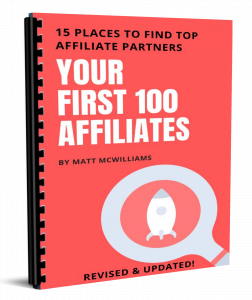 |
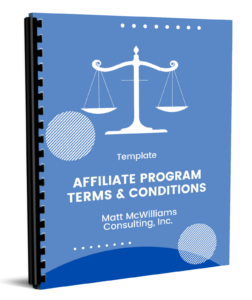 |
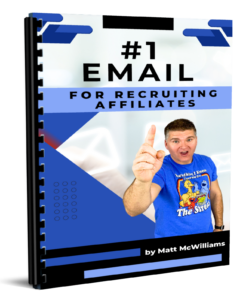 |
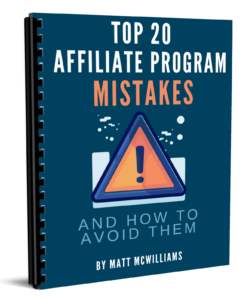 |
 |
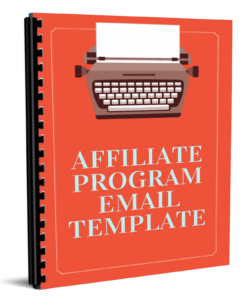 |
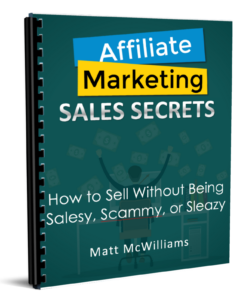 |
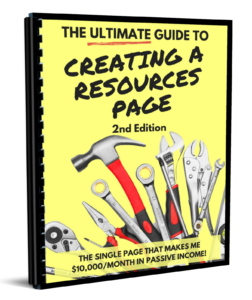 |
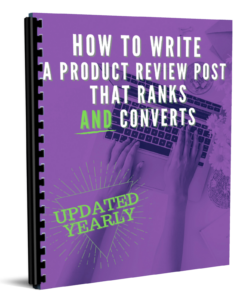 |
